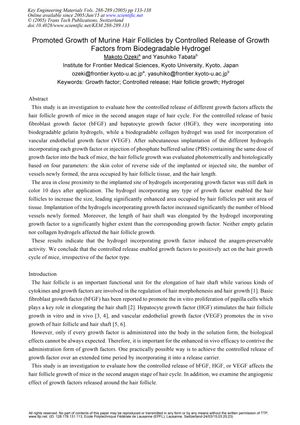TLDR Using hydrogels to slowly release growth factors can effectively boost hair growth in mice.
The study from 2005 examined the impact of growth factors bFGF, HGF, and VEGF, delivered through biodegradable hydrogels, on hair follicle growth in 29-day-old male C3H mice. The hydrogels containing growth factors were implanted subcutaneously and led to significant increases in skin darkness, blood vessel formation, hair follicle tissue area, and hair shaft length compared to controls. Neither empty hydrogels nor direct injections of growth factors had similar effects. The research concluded that controlled release of growth factors from hydrogels effectively promoted the hair growth cycle in mice.
47 citations
,
April 2001 in “Journal of Dermatological Science” IGF-I and HGF attract and stimulate hair follicle cells to move.
 520 citations
,
February 2001 in “Journal of Clinical Investigation”
520 citations
,
February 2001 in “Journal of Clinical Investigation” VEGF helps hair grow and determines follicle size by increasing blood vessel growth.
109 citations
,
April 1998 in “Journal of Investigative Dermatology”  90 citations
,
October 1996 in “Dermatologic Clinics”
90 citations
,
October 1996 in “Dermatologic Clinics” Growth factors are crucial for hair development and could help treat hair diseases.
58 citations
,
April 1993 in “Developmental Biology” bFGF delays hair growth in mice.
 58 citations
,
June 1987 in “Archives of Dermatological Research”
58 citations
,
June 1987 in “Archives of Dermatological Research” EGF and FGF boost hair cell growth, hydrocortisone slows it, and minoxidil doesn't affect it.
60 citations
,
April 2003 in “Biomaterials” Controlled release of growth factors in hydrogels improved hair growth in mice.
56 citations
,
June 2002 in “Biomaterials” Controlled release of VEGF in a collagen hydrogel boosts hair growth in mice.
 76 citations
,
February 2021 in “International Journal of Molecular Sciences”
76 citations
,
February 2021 in “International Journal of Molecular Sciences” Mesenchymal stem cells show potential for skin healing and anti-aging, but more research is needed for safe use, especially regarding stem cells from induced pluripotent sources.
 2 citations
,
September 2022 in “Cytotherapy”
2 citations
,
September 2022 in “Cytotherapy” Fat-derived stem cells show promise for treating skin issues and improving wound healing, but more research is needed to confirm the best way to use them.
 30 citations
,
February 2022 in “Stem Cell Reviews and Reports”
30 citations
,
February 2022 in “Stem Cell Reviews and Reports” Stem cell treatments may improve burn wound healing.






